By Rob Krott
Brrrp! Brrrp! I was putting rounds down range and grinning ear to ear. It was July 1993 and I was the first American (to my knowledge) to ever fire on the weapons range at the old Soviet Spetsnaz Polygon (special forces training base) in Adazi, Latvia. Brrrupppp! Brrrupppp! More automatic weapons fire punctuated the stillness of the forest and the sharp, acrid yet pleasing smell of cordite soon tainted the pine-scented morning air. If you had told me, say ten years ago, that I would someday be standing on the firing range of a Spetsnaz base in the heart of Latvia I would have laughed in your face. As a U.S. Army “cold warrior” the only way I thought I’d ever see a place like this would be while waiting for a bullet as I hung from a parachute and peered past the toes of my jungle boots at little green tracer “footballs” coming up to meet me. Either that or being led out from an interrogation cell on my way for use as an unwilling pop-up target by a bunch of guys named Boris and Ivan. Nope, neither one. Matter of fact, I was standing there happy as could be with a fully-automatic Soviet Stetchkin machine-pistol and watching gunsmoke curl from the barrel. Of course I was surrounded by Latvians, who if they don’t hate Russians, they certainly dislike them. Strongly. The Ruskies, by the way were still garrisoned a few hundred yards down the road. The Latvian press was referring to them as “occupation forces”.
I spent two very pleasant days on the range with new found friends in the Valdibas Apsardzes Parvalde. (VAP, Government Security Service), specifically the Special Intervention Group (SIG). The SIG was Latvia’s counterterrorist and hostage rescue unit. It is now known as OMEGA (See SAR, April 1999, Vol 2 No. 7 “Omega’s Small Arms”).
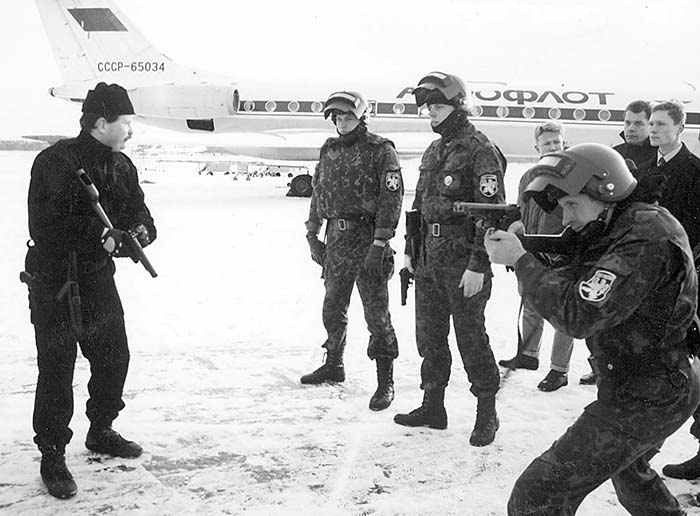
Several of the VIP’s diplomatic bodyguard section carried Soviet Stetchkin machine pistols, and they happily loaned me one. I fired the Stetchkin in the holster-stock configuration. On full automatic. Very sweet, I fell in love. A large, robust pistol but with many good design features, it wasn’t difficult to handle. Its large grip (containing a rate retarding device and big enough to hold a 20-round magazine) provided plenty of purchase for two hands. Overall quality of the materials used in production is high and tolerances were good. The Avtomaticheskiy Pistolet Stetchkina, 9x18mm Makarov caliber, was fielded in Soviet military, police and KGB armories in 1951. It was issued for use in special operations and special police task such as diplomatic bodyguard details and convert counterterrorism operations. It also saw some use as a sidearm for armored vehicle crews. The APS was designed by Igor Yakolevich Stetchkin, then a Tula Arsenal engineer and designer.
Development
The Stetchkin’s design parameters as set by the Red Army called for a 9-mm selective fire pistol with a large magazine capacity that would use its holster as a shoulder stock (ala the 9mm Parabellum firing Mauser M1932 or M172 Schnellfeuer pistole also known as the “Broomhandle”) and have an effective range of 200 meters. A design team was headed up by I.Y. Stetchkin in 1950. Stetchkin, the son of a doctor, had risen to the position of engineer at the Tula Mechanical Institute during World War II. After producing an approved design a working prototype was manufactured. It performed acceptably and modifications were made to two test weapons. Comparison testing was done with the Mauser Schnellfeuer and its Spanish copy, the Astra Model 902 aka Model F (both in 7.63mm Mauser) and the Soviet Sudarev PPS-43 submachine gun which fires the 7.62mm Tokarev cartridge. Stetchkin remarked that his design performed better than the Mauser and the Astra and nearly as well as the Sudayev. After further modification and extensive troop trials the APS was adopted into service with the Soviet Army in 1951. In 1952 Stetchkin was awarded the State Prize for his development of the APS.
Technical Specifications
The APS was designed to fire the 9x18mm 93-grain FMJ steel-core Makarov cartridge (the APS was introduced by the Soviets at the same time as the Makarov). Muzzle velocity is about 1100 feet per second. Field tests by western intelligence analysts have found the Stetchkin achieves a muzzle velocity of 1,063 fps for East German manufactured by Makarov ammunition and 1,096 fps for Hungarian ball ammo. The same ammunition test fired in a Makarov produced muzzle velocities of 1,006 and 1,015 respectively. The noticeable gain in muzzle velocity can be attributed to the Stetchkin’s longer barrel. This weapon used a 20-round detachable staggered or double stacked box magazine. The double or two-position feed magazine, which feeds from both sides alternatively, has a spring exposing cut-out which allows for cartridge capacity checks. The receiver is of forged steel with a milled finish. The high quality salt-blue held up well on all examples I fired or handled. Weight was conserved where ever possible so the weapon weighs only 2.25 pounds (1.02 kg) empty (less than a Colt 1911A1 .45 ACP. With a full 20 round magazine it weighs 2.7 pounds (1.22 kg). Its chrome lined, fixed barrel (pinned in place like a Walther PP) is 5.5 inches (140mm). Overall length of the pistol is 8.9 inches (225 mm) – add the stock and it is nearly 21 inches (533 mm) – and height is 5.9 inches (149 mm). It has a chrome-lined bore and reddish-brown bakelite synthetic grips. Variations also exist with smooth wood grips. The barrel has four right-hand twist riflings.

A 14.5 inch (368 mm) long wood combination stock and holster, like that used with the Broomhandle Mauser M712, with a belt clip (a spring clip with two sling eyes) for right-side belt carry and sling can be quickly clipped to the pistol butt. While all the Stetchkins I’ve fired or seen had wood holster-stocks plastic versions were also manufactured. A sling or lanyard eye on the left side of the pistol just behind the trigger provides for retention of the weapon. The sling is attached much like the Mauser Broomhandle stock, except in reverse. The male attachment on the pistol butt’s backstrap is inserted into a matching female T-slot cut in the steel endcap of the stock. A spring catch locks it into place. The clip-on stock can then be disconnected from the pistol via a butt-cap mounted release catch. The pistol is stored in the holster by way of a hinged top (like the Mauser stock-holster) which allows the butt of the Stetchkin to protrude to the rear when clipped on the right side of the belt, much like any conventional holster. A simple press stud indented into the stock just below the hinged top activates a spring catch to unlatch the lid for drawing or removing the pistol.
Inside the holster-stock is a combination screwdriver and cleaning rod. The sling which can be clipped to both the sling connection on the stock and the sling eye on the pistol behind the trigger. The Latvians (and also the Estonian Police), however, clip both ends of the sling to the sling eye on the right, or non-firing side of the stock. Four spare 20-round magazines are issued with a double flapped leather magazine pouch.
The APS is sighted for 200 meters. The rear sight elevation is adjusted via a knurled drum between two protective flanges. The open U-notch rear sight can be set from 25 meters up to 200 meters with incremental settings at 50 meters and 100 meters. The front sight is a fixed blade.
The Stetchkin uses a two-stage single-action five pound trigger while the double action breaks at about fifteen pounds.
Mechanical Functioning
The APS is a non-locking blowback design. This unlocked breech design is largely responsible for the relatively light weight of the Stetchkin. Such a non-locking blowback action is possible using the low-power 93 grain 9x18mm Makarov cartridge. When the Stetchkin is fired the breech of the weapon remains closed from the weight of the slide and pressure from the recoil spring. The side is actioned to the rear via gas pressure exerted on the base of the cartridge case. The hammer is re-cocked and the spent cartridge extracted and ejected. The slide is sent forward by the recoil spring, chambering another cartridge and closing the breech. In semi-automatic fire the trigger does not engage the hammer until the trigger is released and pulled again to fire.
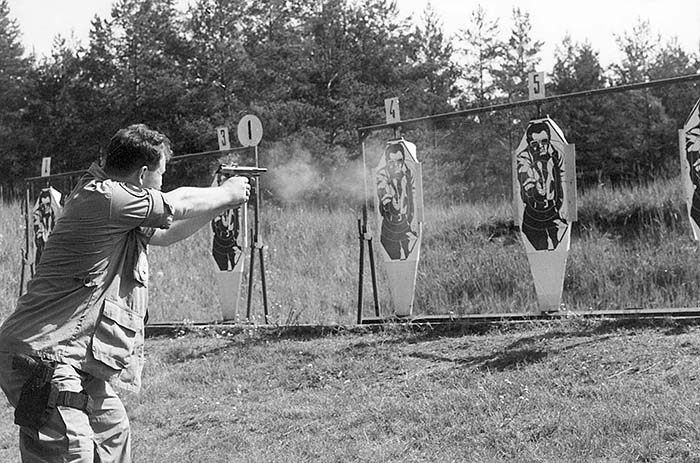
Pulling the trigger repeats the sequence. In the full-automatic fire mode the hammer is automatically tripped as the breech is closed, firing another cartridge and this sequence repeated. There is a spring-loaded plunger in the grip between the frame backstrap and the magazine-well which acts as a rate reducer in the full-automatic firing mode, limiting the effective cyclic rate of 700 – 750 rounds per minute. The plunger is activated by a transfer lever (initiated by a slide lug) as the slide cycles rearward. On the upstroke it impedes the firing of a second round (in the semi-auto mode) when it engages with the transfer lever and selector. Besides lowering the cyclic rate to a manageable level in full-automatic is also functions as a slide buffer and reduces the recoil velocity of the slide.
Loading and Firing
To load the magazine simply press a cartridge into the magazine until it catches under the feed lips. The next round is pressed down directly on top of it. Insert the loaded 20-round magazine into the magazine well at the butt until it engages the magazine latching lug. The APS three position selector switch is on the left side of the slide along with a hammer-drop safety. To operate: set it at OA (Cyrillic OD) for single shots, then to NP (Cyrillic PR) for safe (where it locks the hammer and slide), and all the way back to ABT (Cyrillic AVT for avtomat) for full auto fire.
On “safe” the firing pin is locked and the hammer is tripped to a locked position. Note that the hammer and slide are now locked. The selector must be moved to either semi-auto or full-auto before the slide can be pulled to the rear to chamber / eject a round. Pulling the trigger in either firing position will cock the hammer, in double action and release it to fire the first round. Trigger functioning is then single action. The first round or burst can also be fired single action, but only by manually cocking the hammer. On full-auto the cyclic rate of 700-750 rounds per minute will quickly – in 1.6 seconds or so – empty the 20 round magazine. There is a hold open device consisting of a lug on the magazine follower which engages the slide to lock it open after the last round is fired.
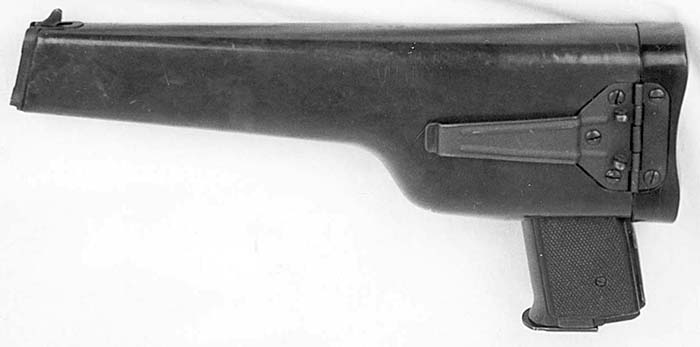
The Stetchkin will also reportedly reliably fire the 9mm Kurz or 9mm “Sort” (.380 caliber) ammunition. The case diameter of the 9mm Makarov is .309 inches and case length is .68 inches while that of the 9mm Kurz is .372 inches and .71 inches, respectively. Expended cartridge cases of the smaller .380 caliber cartridge usually will be bulged. Note also that the cyclic rate will drop and the velocity and accuracy will be likewise effected. But it will chamber, fire and eject. (NOTE: Neither the author nor Small Arms Review advises firing any cartridge in a weapon except the particular round that the weapon is specifically designed for).
Unloading and Clearing
On a Stetchkin with the slide forward, point the weapon in a safe and neutral direction and insure the selector switch is on either semi-auto or full-auto. Pull and hold the slide to the rear. Observe for ejection of a chambered round. Engage the slide release-catch (located on the left side of the receiver below the slide and just forward of the selector switch / safety as on most automatic pistols). Release the magazine (like the Makarov the magazine catch is a knurled button on heel of the pistol butt). Inspect the chamber.
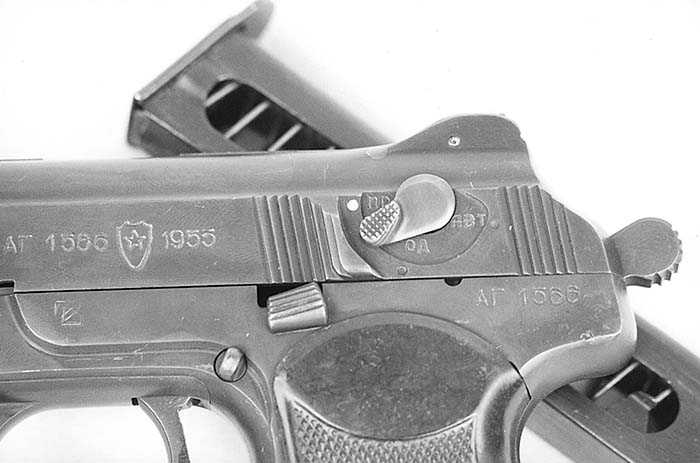
To clear the weapon with the slide locked to the rear; inspect the chamber. Release the slide. Release the magazine catch and draw out the magazine. You can then re-cock the slide and inspect the chamber if desired.
Field Stripping
To disassemble the Stetchkin: First, clear the weapon and remove the magazine. Insure the selector is on either semi-auto or full-auto. Like the Makarov, the trigger guard of the APS is pulled down to initiate disassembly. It will be held in the down position (unlike the Makarov or Walther) by a spring-loaded catch stud. Next, pull the slide back to the recoil spring and lift the slide from the frame. Pull the recoil spring off the barrel. Disassembly is complete. Further or complete disassembly necessitates the use of armorer’s tools to disassemble the trigger mechanism, hammer, selector switch, firing pin, safety, rate retarder – grip spring, and grips.
KGB Assassination Weapon?
The Stetchkin was also manufactured in a fully suppressed version, known as the APS-B (Besshumniye or “without noise”). At least one of these “silenced” Stetchkins was captured in Afghanistan. This version of the Stetchkin had a wire buttstock rather than the wood or plastic holster stock and sported a long muzzle suppressor which was offset so that the sights are not occluded while attached. The barrel was ported (reducing bullet velocity to a suppressible subsonic level) with four small ports near the chamber and eight more, larger ports near the barrel. The barrel diameter between the ported sections was reduced and the barrel then ensconced in a tubular gas expansion sleeve. This tubular expansion sleeve (fitting over the barrel and extending nearly two inches beyond the slide) is locked into place by lugs fitting into two notches in the frame. The suppressor (which could be attached to the stock for carrying) is screwed onto the expansion sleeve by a helical thread – two twists and it’s on – is retained by a spring-catch. The front of the slide is cut out to accept the suppressor and a larger diameter recoil spring. Both the suppressor and the pistol with stock were issued in a large leather flap holster with two individual pockets: one for the pistol and the other for the stock and suppressor. This version of the APS was probably used for covert operations by KGB operatives; it is relatively rare. In this configuration it was ideal for carrying out KGB”hits.” Especially by motorcycle mounted drive-by shooters if the target is standing on a street corner. It could also be used (in the fashion which the M-11 Ingram was supposedly designed for) to take out “a room full of very surprised colonels.”
There were also specially presented Stetchkins, no doubt to foreign military dignitaries. Boxed in a wood presentation case lined in green wool baize were a Stetchkin with polished stock, leather sling and four magazines with pouch.
Tactical Critique
The Stetchkin can be fired full-auto, single handed as the rate reducer and long recoil spring minimizes recoil. Muzzle climb is drastic, even with the shoulder stock attached, when firing long bursts. Short three round bursts allow for the best accuracy. With aimed, semi-auto fire from a stable firing position (sitting-supported or prone) by a trained marksman the Stetchkin will group on man-sized silhouettes out to 150 meters.
With a little practice the Soviet requirement of effective accuracy to 200 meters could be achieved, however, it is truly pushing the envelope for both weapon and cartridge. Accurate full automatic fire degrades considerably beyond 25 meters. In firing the Stetchkin with the stock affixed I was able to consistently hit man-sized silhouette targets at that range with 3-5 round bursts from the standing off-hand. This is course could just as easily have been achieved using most any submachine gun. Without the stock it punches twenty holes in a man-sized silhouette at about 10 meters only by controlling the pistol dramatically between bursts. As a close combat weapon it is excellent, if only for its rapid, multiple hit capability and ease of engagement.
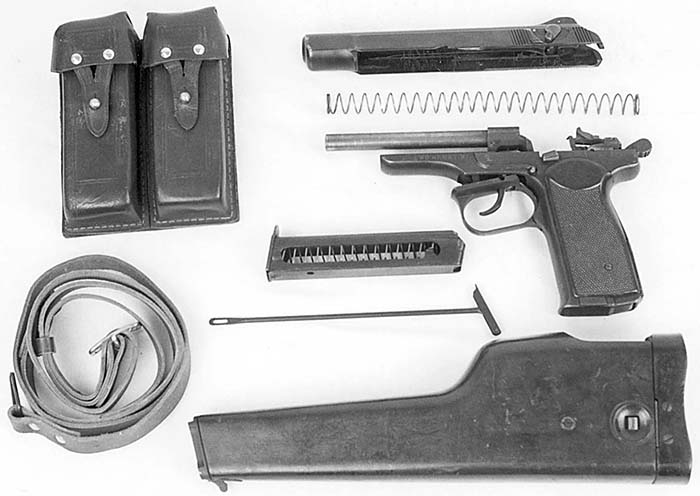
The Stetchkin is one of the true machine pistols, defined as handguns designed to fire in full automatic, as opposed to small submachine guns such as the Micro Uzi or the Czech Skorpion Model 61 .32 ACP submachine gun. The Broomhandle Mauser, Spanish Stars, Heckler & Koch VP70z, Glock 18, and Beretta 93R, are all weapons designed for this purpose. Individual examples of other handguns such as the Colt 1911 have been converted to fire full-auto, but were not originally designed for this purpose.
There may very well have been political reasons for development of the Stetchkin. At about the same time as it was being designed Stalin viewed the increasing popularity of certain communist party aparatchiks from Leningrad with suspicion. The successful defense of the city during the Siege of Leningrad was an epic victory of the Soviets over the Germans. Faced with a shortage of small arms the PPS-42 (Pistolet-Pulemet Sudayeva M1943) was quickly designed by a military engineer. A.I. Sudarev, to make use of existing machine tools, parts and ammunition.
It was a crude but efficient submachine gun constructed almost entirely of heavy steel stampings and held together with spot welds, pins and rivets. This weapon became a symbol of the victorious defense of Leningrad (now again called St. Petersburg). Because of this visual link with the past and with the Leningrad leadership, Stalin ordered the removal of the weapon (continued in production with minor modifications as the PPS-43 until 1945) from Red Army armories in order to banish it from sight and from the consciousness of Soviet citizens. This was a major undertaking as nearly 1 million of these weapons were produced. A replacement may have been part of the plan. Hence the comparison at the arms trials of the prototype Stetchkin and the PPS-43. While this is only speculation on my part, it would be a better motive than simply deciding to arm troops with a machinepistol which was neither as portable as a Tokarev nor as accurate as a submachine gun. The Kalashnikov was also in full production at this time which further begs the question: why a machinepistol? An arms historian can also draw a link between the popularity of the Mauser 1920 Bolo pistols (Bolo being short for Bolshevik at the time) supplied in quantity by Mauser to the Soviet Union. The Bolo was chambered for the bottlenecked 7.63mm (.30 Mauser), a cartridge which became more popular than the pistol. The Soviets adapted this pistol cartridge to become the Tokarev 7.62mm, which can also be fired in the .30 Mauser pistols. Perhaps some Soviet general or Communist Party official enamored of the Bolo Mauser (politically incorrect for use as it was a German weapon), but not very knowledgeable about weapons and modern warfare wanted a suitable replacement.
Filling no real purpose (except perhaps in special operations) it did not enjoy widespread success and was largely withdrawn from service by 1980. The APS, however, was fielded by the Soviets or their satellites (especially Bulgaria) to various “wars of liberation” and guerrilla groups. The Stetchkin would be a handy weapon for arming field advisors and rear area specialists and it has popped up in Afghanistan, Mozambique, Angola, Rhodesia, Libya and Zambia. In 1996 three Stetchkins with ammunition and seven magazines along with thirteen handgrenades were found by South African police in a mielie field near Krugersdorp. They were probably an abandoned ANC weapons cache. The most infamous incident involving a Stetchkin occurred in January 1989 in Holland when a Bulgarian truck driver was detained by police after they noticed the undue attention he was paying to NATO bases. A search of the truck revealed a Stetchkin concealed in the cab. This was probably the last major incident involving hard espionage during the Cold War.
Considered rare, relatively arcane, and supposedly removed from general service in the USSR by 1985, I was surprised to find it in such general use amongst special operations units in the Baltics as late as 1995. I would guess that these have been largely supplanted by H&K MP-5s in Estonia and Micro Uzis in Latvia. However, if the Balts were making use of the weapon just a few years sago, then I suspect some elements of the new Russian Army might be as well. At the time I first fired the Stetchkin (1993) I was told it was available on the black market for $1,000 (USD). Following the collapse of communism in the Soviet Union a quantity of Stetchkins were undoubtedly removed from storage in state armories and peddled for hard currency. Counterterrorism instructors were warning students of the use and availability of this weapon to terrorists, assassins and criminals.
Various attempts to turn automatic pistols (semi-auto and select fire) into carbines via the addition of a shoulder stock holster prior to development of the Stetchkin met with mixed results. The most well-known machinepistols or pistol carbines include: the Mauser; the Astra; the Star Pistol Carbine Model “A” and its select fire version Model “M”; the long barreled P08 Model 1914/1917 “Artillery” Luger (further encumbered with a 32-round snail magazine’ and various 9mm FN Browning Hi-Power manufactures. None of these were great successes as general-usage military weapons. Stocked pistols are neither as accurate as carbines and submachine guns nor as portable as pistols. Perhaps the Soviets merely needed to find out for themselves what the Germans and the Spanish already knew.
US Lore of the Stetchkin
“Common Knowledge” dictated that the only Stetchkin machine pistol in the US was secretly stashed at Langley in the possession of the CIA. Rumors of one held by a Vietnam Veteran who took it from the body of a “Large Caucasian” in a cross border op during the Vietnam war were followed up by this author, to find he did not have the gun, but was a dog handler with the Marines who did in fact discover one on a “Large Caucasian” with a leather pouch full of documents and a Stetchkin, but as he and his team mates examined it, several of the CIA personnel who had called his K9 team in for a body search quickly removed it and the pouch. He did not have the gun. It was not supposed to have happened. He had the credentials to back up his story.
The ATF booklet on Curio and Relics lists the Stetchkin APS machine pistol, and has ever since I remember the publication. This would indicate, but not guarantee, that there is at least one registered transferable Stetchkin in the US.
LMO purchased 50 Arsenal refinished and new Stetchkin APS machine pistols in the early 1990’s. These were packed 25 per wooden chest, with plastic stocks, slings, and magazine pouches. Approximately 25 were imported for law enforcement use or as dealer sales samples, and are restricted as “Post 86 dealer samples”. The balance of the guns had the receivers destroyed and were imported as parts sets. Most of these were made into dummy guns, but some were reportedly redesigned into a semi automatic version by a Midwest manufacturer. With the stocks, these would have required registration as Short Barreled Rifles.
From the Stetchkins that were seen, it would indicate that the dates of manufacture were 1951 until 1955.
One of the suppressed versions is in the possession of the Royal Pattern Room in Nottingham, and SAR hopes to bring the story and pictures of that piece to the readers in a future issue. – Dan
| This article first appeared in Small Arms Review V3N1 (October 1999) |











